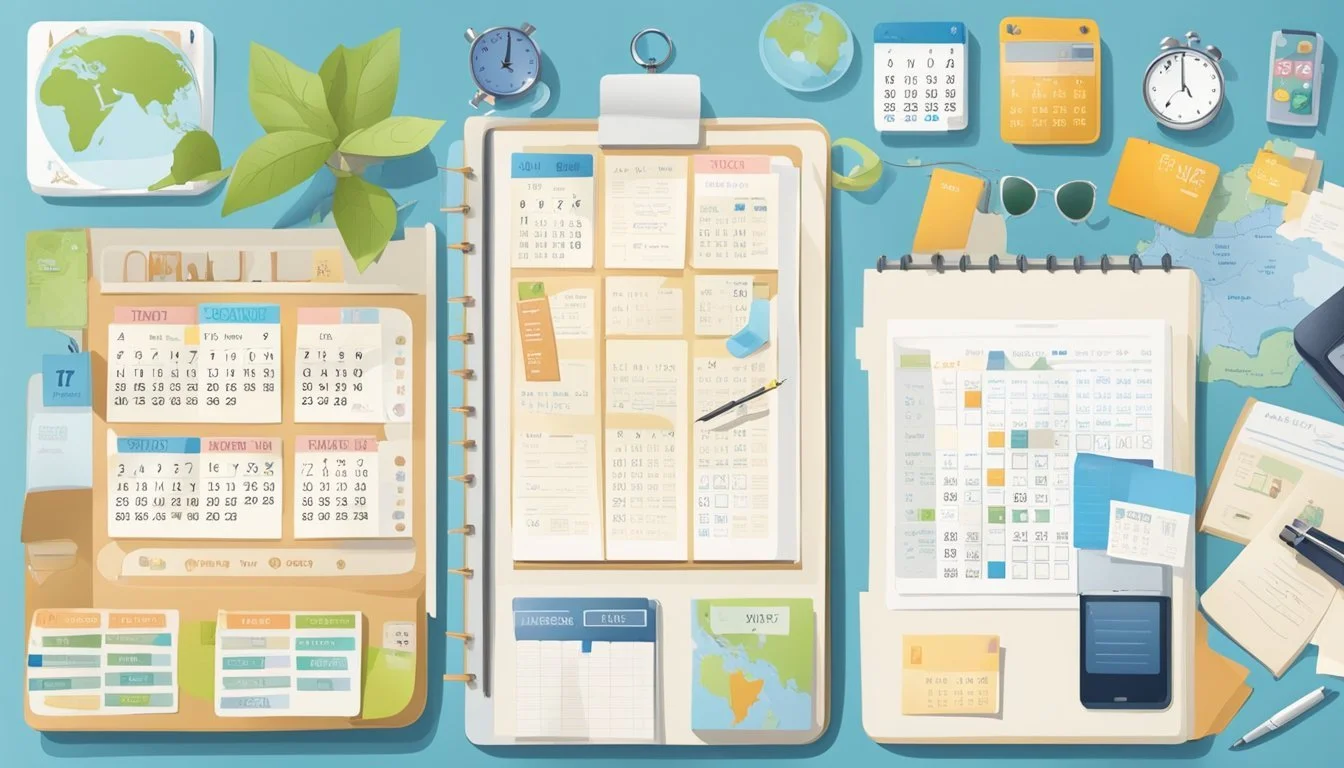9 Tips for Navigating a Long-Distance Relationship
Strengthen Your Bond
Navigating a long-distance relationship can be challenging but also deeply rewarding. Many couples face the difficulty of maintaining a strong connection while being miles apart, which requires effort and intentionality. The key to success lies in effective communication, mutual trust, and creative ways to stay connected.
Understanding how to keep the bond alive despite the physical separation is crucial for the long-term success of the relationship. Couples can explore various strategies and activities to bridge the distance and strengthen their emotional ties. By following practical tips and staying committed, partners can turn the challenges of a long-distance relationship into opportunities for growth and deeper connection.
1) Prioritize Communication
Staying connected is crucial in a long-distance relationship. Regular communication helps maintain emotional intimacy and keeps partners on the same page. It is essential to set up a routine for daily check-ins. These can be brief messages or video calls, ensuring both partners feel present in each other's lives.
Making use of various communication tools can also help. While text messages and phone calls are common, video calls add a personal touch that mimics face-to-face interaction. Effective communication is not just about quantity but quality, focusing on meaningful conversations rather than just updates.
It's important to express feelings openly. Sharing joys, frustrations, and dreams allows each partner to understand the other's emotional landscape. This builds trust and emotional support, which are vital for fostering a strong connection. Clear and honest communication can prevent misunderstandings and help resolve conflicts promptly.
Partners should prioritize connecting rather than just talking. Real connection occurs when conversations are two-way streets where both feel heard and valued. Listening actively and responding thoughtfully enhance the depth of the relationship.
For more detailed information on how communication forms the bedrock of successful long-distance relationships, visit VeryWell.
2) Set Clear Expectations
Setting clear expectations is crucial for any long-distance relationship. Couples should discuss their needs and desires straightforwardly. This helps prevent misunderstandings and sets the foundation for a stable and trusting partnership.
Partners should agree on communication frequency. They need to decide how often they will call, text, or video chat. By doing this, they avoid feelings of neglect or being overwhelmed.
Defining relationship boundaries is also important. Each person should know what behaviors are acceptable and what are not. This mutual understanding strengthens trust and reduces insecurities.
Couples should also discuss their long-term goals. It’s vital to have a shared vision about the future. This could involve plans for visits, moving closer together, or other significant milestones.
Flexibility is key. While setting expectations, it’s important to not be overly rigid. Life is unpredictable, and the ability to adjust is essential. Communicating any changes promptly helps maintain harmony and understanding.
3) Plan Regular Visits
Planning regular visits is vital for sustaining a long-distance relationship. Face-to-face time can strengthen bonds and provide essential physical interaction.
Setting a schedule for visits helps both partners look forward to these reunions. This can foster a sense of stability and reliability.
Even short trips can make a significant impact. A quick weekend getaway can recharge emotional connections and offer a needed break from routine.
Consider alternating travel responsibilities to balance the effort and expense. This can ensure that both partners feel equally invested.
Regular visits offer opportunities to create lasting memories. Shared experiences can be a cornerstone in maintaining connection despite the distance.
Maintaining flexibility with travel plans can also be important. Life can be unpredictable, so being adaptable is beneficial.
Effective planning of visits can make the time apart more bearable and the time together more meaningful. Prioritizing these meetups shows commitment and dedication to the relationship's success.
4) Make Use of Technology
Leveraging technology is crucial in maintaining a long-distance relationship. Many tools exist to help couples stay connected despite the physical distance.
Video calls are among the most effective ways for partners to see each other regularly. Applications like Zoom, Skype, and FaceTime make it easy to have face-to-face interactions. This visual component can strengthen the emotional bond.
Text messaging and instant messaging apps like WhatsApp and Telegram allow for continuous communication throughout the day. Sharing daily updates and little moments can recreate the feeling of being close.
Social media platforms offer another way to stay connected. Sharing photos, videos, and stories on Instagram or Facebook can keep both partners involved in each other's lives.
Planning joint activities online, such as streaming movies together using apps like Netflix Party, can make shared experiences possible. It helps to maintain a sense of normalcy and togetherness.
Using online calendars to schedule visits or important dates can ensure both parties are on the same page. This can help in making plans and avoiding misunderstandings.
Sending virtual gifts or letters can also add a personal touch. Websites and apps provide various options to send thoughtful gestures even from a distance.
Making use of technology in these ways can bridge the gap, fostering communication and maintaining the relationship's strength.
For more detailed tips on utilizing technology in long-distance relationships, visit WIRED or Calm Blog.
5) Surprise Each Other
Surprising your partner plays a crucial role in keeping the excitement alive. Little gestures can make a big difference in a long-distance relationship.
Sending a handwritten letter or small gift can be very impactful. These tangible items serve as physical reminders of your affection and thoughtfulness.
Unexpected visits, when feasible, are powerful ways to renew your connection. Planning takes some effort, but seeing the joy on your partner's face makes it worthwhile.
Digital surprises can be equally effective. Organize a surprise video call or send an unexpected photo or video message to brighten their day.
Creating playlists for each other adds a personal touch. Music can convey emotions that words sometimes struggle to express, helping you feel closer despite the distance.
Trade books or movies you love and discuss them together. Experiencing each other's favorites fosters a deeper connection and shared understanding.
Organize virtual date nights centered around games or cooking sessions. Shared activities bring a sense of togetherness and fun, bridging the physical gap.
Exploring creative ways to surprise each other helps maintain enthusiasm and shows that you value the relationship, no matter the distance.
6) Stay Positive
Maintaining positivity is essential in a long-distance relationship. Staying optimistic can significantly enhance the bond between partners, helping them navigate challenges more effectively.
A positive outlook can make the distance seem less daunting. By focusing on the good aspects of the relationship, both partners can feel more content and motivated.
Celebrate small victories. Whether it’s a successful video call or an unexpected message, acknowledging these moments can reinforce the connection.
It's crucial to remember why the relationship is worth the effort. Reflect on shared goals and future plans, as this can help sustain a positive mindset.
Engaging in activities that bring joy and fulfillment can also help. When individuals feel good about their lives, they're more likely to bring that positivity into the relationship.
Encouraging each other during tough times can make a big difference. Simple acts of support and reassurance can boost morale and maintain a healthy, positive dynamic.
Staying positive doesn't mean ignoring challenges. Instead, it’s about facing them with a constructive attitude and believing in the relationship’s potential.
7) Keep Busy with Hobbies
Staying occupied with hobbies can be a vital aspect of maintaining a healthy long-distance relationship. When individuals engage in activities they love, it can help manage feelings of loneliness and provide a sense of fulfillment.
Painting, reading, or playing musical instruments can be excellent ways to channel energy into something productive. It's essential for both partners to maintain their sense of self and personal growth, even while apart.
Sharing these hobbies can also bring partners closer. They might exchange paintings, discuss books they’ve read, or share recordings of songs they’ve played, fostering a deeper connection through mutual interest.
Engaging in physical activities, such as jogging or yoga, can also be beneficial. Not only does it promote physical health, but it can also have a positive impact on mental well-being.
Learning new skills or taking up new hobbies can be an exciting journey. Partners can enroll in online courses together or individually and share their progress.
Volunteering or community involvement can add a sense of purpose to one's daily routine. It ensures they are contributing positively to their surroundings while keeping themselves engaged.
Maintaining hobbies helps create a balanced lifestyle, which is crucial in navigating the challenges of a long-distance relationship.
8) Be Honest About Your Feelings
Honesty is crucial in a long-distance relationship. Share your feelings genuinely and openly with your partner. This transparency helps in building trust and maintaining a strong emotional connection.
Express your concerns and fears, no matter how small. If something bothers you, addressing it early can prevent misunderstandings and resentment later on.
Discuss both positive and negative emotions. Celebrating joys together is as important as sharing sorrows. It allows both partners to feel equally involved in each other's lives.
Being transparent about day-to-day activities fosters a sense of closeness. It reassures your partner that they're still a significant part of your daily life despite the physical distance.
Acknowledging loneliness or insecurity can also be beneficial. It lets your partner know that you need extra support, and they can offer reassurance or make special efforts to stay connected. Sharing these feelings can bring both partners closer and reduce emotional distance.
Honesty encourages mutual understanding and empathy. It paves the way for a healthier, more resilient relationship, even when miles apart. Ensure that both partners feel comfortable expressing their true emotions without fear of judgment. This practice strengthens the bond and promotes a trusting partnership.
9) Send Handwritten Letters
Sending handwritten letters offers a personal touch that digital communication often lacks. They provide a tangible reminder of a loved one and can be kept as a keepsake. This simple gesture can evoke nostalgia and warmth, strengthening the emotional connection between partners.
Handwritten letters allow individuals to express their thoughts and feelings in a unique way. The time and effort put into crafting these letters demonstrate care and thoughtfulness. This can deepen the bond in a long-distance relationship.
Letters give recipients something physical to hold, which can help with feelings of loneliness or distance. They can be read and reread, providing comfort and reassurance during challenging times.
Beyond just words, letters can include small mementos like pressed flowers, photos, or even doodles. These additions make the communication even more special, showing a personal touch that digital messages can't match.
Writing and receiving letters can become a cherished ritual, creating anticipation and excitement. This practice can bring a sense of closeness and intimacy, helping partners feel more connected despite the miles between them.
Understanding the Challenges of Long-Distance Relationships
Long-distance relationships present unique emotional and communicative challenges. Addressing these issues is crucial for maintaining a healthy relationship over time.
Common Emotional Struggles
One significant emotional challenge in long-distance relationships involves feelings of loneliness. Being physically apart from a partner can lead to emotional distress and a sense of isolation. This can sometimes cause insecurities and anxiety about the stability of the relationship.
Another prevalent issue is trust. The absence of physical presence can amplify doubts and fears about a partner's fidelity and commitment. Transparency and openness are key to alleviating these concerns.
Lastly, the lack of physical intimacy can create a sense of disconnect. While emotional bonds are critical, physical touch and proximity are also important for many couples. Finding ways to feel connected despite the distance is essential for emotional well-being.
Communication Barriers
Effective communication is often a hurdle in long-distance relationships. Time differences and busy schedules can make it challenging to maintain regular contact. Partners need to establish a routine that works for both to ensure consistent communication.
Without face-to-face interactions, misinterpretations can occur more frequently. Non-verbal cues like body language and facial expressions are missing, which can lead to misunderstandings. Using clear, explicit language can help mitigate this issue.
Technology plays a crucial role in bridging these gaps. Utilizing various communication tools such as video calls, messaging apps, and social media helps maintain a connection. Embracing technology not only aids in regular communication but also enables sharing experiences in real-time.
Effective Communication Techniques
Building effective communication in a long-distance relationship involves using platforms that allow for real-time interaction. Regular video calls and consistent use of messaging apps help maintain intimacy and connection.
Regular Video Calls
Regular video calls are an essential part of maintaining a close connection. Seeing each other's faces helps couples feel more connected and alleviates the loneliness that often comes with long-distance relationships. Platforms like Zoom, Skype, and FaceTime make it easy to schedule these virtual dates.
Planning specific times for video calls can create a sense of routine and stability. These calls can also be used for various activities, such as virtual dinners, movie nights, or simply catching up on each other's day. Engaging in meaningful conversation during these calls strengthens emotional bonds.
It's important not to over-plan these sessions to avoid adding stress. Flexibility ensures that both partners remain comfortable and look forward to these moments rather than feeling obligated. In essence, video calls can serve as a strong foundation for maintaining intimacy despite the miles apart.
Using Messaging Apps
Messaging apps are indispensable tools for daily communication. They allow couples to stay in touch throughout the day, sharing moments and thoughts in real-time. Apps like WhatsApp, Telegram, and iMessage offer features like voice notes, photos, and video clips that add a personal touch to the conversation.
Consistent and thoughtful messaging keeps the relationship vibrant. Sharing flirty texts or candid updates about one's day can make the other person feel cherished and involved. Scheduling "good morning" or "good night" messages can also create a comforting routine.
However, it's crucial to balance the frequency of messages to ensure it feels natural and not overwhelming. Using a mix of casual and meaningful messages helps maintain a healthy communication pipeline. Leveraging the versatility of these apps can significantly enhance the feeling of closeness and understanding between partners.
Maintaining Trust And Commitment
Healthy long-distance relationships rely on clear boundaries and addressing insecurities promptly. These elements are essential in ensuring both partners feel secure and valued.
Establishing Boundaries
Setting clear boundaries is essential in maintaining trust. Each partner should communicate their expectations regarding communication frequency, social interactions, and personal space. This avoids misunderstandings and conflicts.
Communication Frequency: Partners should agree on how often they will communicate. Daily or weekly check-ins can provide a sense of routine and stability. Knowing when to expect contact helps manage expectations.
Social Interactions: Discussing social activities and friendships helps build trust. Being open about social plans and who they are spending time with can prevent feelings of jealousy or suspicion.
Personal Space: Respecting each other’s need for personal time is crucial. Even in a long-distance relationship, partners need time to focus on their own hobbies, work, and personal growth. Setting boundaries for alone time ensures that both individuals do not feel overwhelmed or pressured to be constantly available.
Addressing Insecurities
Openly addressing insecurities helps strengthen emotional connection. Importantly, partners should feel comfortable discussing their fears and doubts without fear of judgment or dismissal.
Open Communication: Encouraging honest conversations about insecurities is vital. Both partners should feel free to express their concerns and work together to find solutions. This openness fosters a deeper connection and mutual understanding.
Reassurance: Regularly reassuring each other of their love and commitment can alleviate insecurities. Small gestures, such as sending thoughtful messages or surprise gifts, can go a long way in making a partner feel cherished.
Self-Work: Each individual should also work on their self-confidence and emotional well-being. Addressing personal insecurities internally can reduce emotional strain on the relationship. Practicing mindfulness, engaging in self-care routines, and seeking support from friends or therapists can be beneficial.
Ensuring open dialogue and mutual efforts to address vulnerabilities can help build a stronger, more resilient relationship. These approaches create a foundation of trust and commitment crucial for long-distance partners.




